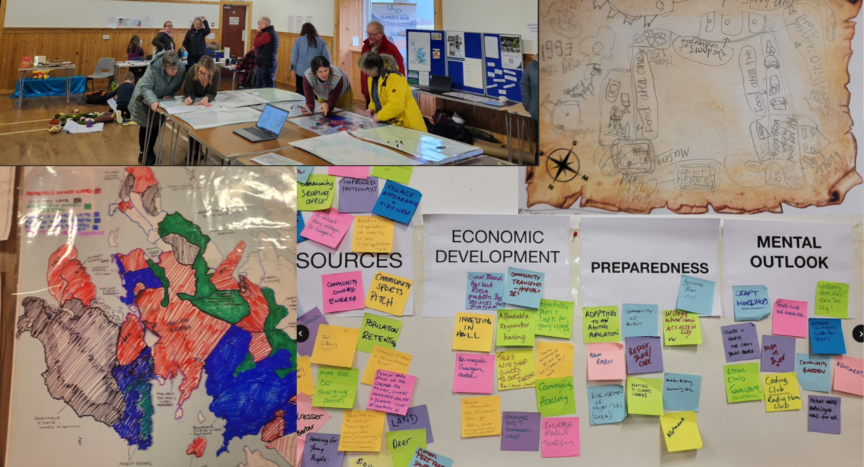The lack of access to affordable housing is an issue affecting areas across the country but acutely felt here in NW Skye, with the average house price hitting at least 10x the Dunvegan Community Council (DCC) area median wage. To put this into a wider context, the average house price for the mainland is 6x the national median wage. With the last affordable homes built in Dunvegan over 20 years ago, and the number of private lets available in the area declining over that period, it’s unsurprising that we have arrived at a point where young people and families struggle to find and afford homes to live here. North West Skye has been designated a ‘fragile area’ in recent government policy research, and in terms of demographic change, NW Skye has suffered a more dramatic loss of young people (as well as working age people generally ) over that time than the Western Isles, the rest of the Highlands, and also the other 2 ‘fragile areas’ , Raasay and North Skye. It’s fairly obvious that this trend makes for an unsustainable situation in terms of provision of services, social cohesion and vibrancy , and we have evidence now to capture the views and needs of the community in relation to housing, both through the Housing Need Survey Report and the Community Action Plan Survey Report(CAP Survey Report is still a Draft, so please feedback with comments! More info on the CAP here). In the Housing Need Report, it is evidenced that:
- Most respondent households (72%) were owner-occupiers
- 15% living in social housing
- 5% each in private rents or employment tied housing.
Of those:
- 12% were currently in insecure housing
- 12% said their current home did not meet the needs of all household members.
In terms of community perceptions, 95% of respondants agreed that our community needs more affordable housing: An overwhelming majority.
85% agreed, 15% were unsure that Local people have had to leave for housing, and similarly 85% agree, 11%were unsure, and 4% disagreed that Local people will have to leave: Matching percentages in agreement suggests that differences in opinion are a matter of experience of this issue.
Local businesses reported a high level of impact of the lack of affordable housing in terms of recruiting and keeping staff. In a wider context, the Skye Business Housing Needs Study conducted in 2022, commissioned by Skye Connect, found that up to 1,700 jobs across Skye and Lochalsh were vacant during the year because workers could not find a home in the area.
Lochalsh and Skye Housing Association are building 16 houses for affordable rent as part of the Masterplan project at the Primary School. This will make a big difference to the current deficit of housing – The CHT assess current demand in DCC as 25 homes (including the 16 already planned for the school site). However, the data evidences 47 households in total needing accommodation by 2030 – Housing demand and provision is dynamic and even with the LSHA development, we can’t let another 20 years pass without review and action.
So, what can we do, right now?
Land is expensive too, and much of the land in Dunvegan CC is under crofting tenure. We do have 2 publicly owned, unoccupied houses in the DCC area – Orbost Farmhouse, which is owned by HIE, and the Police House Dunvegan, owned by the Police Authority. HIE is keen to divest itself of as much of Orbost Estate as it can, and they would be happy to see much of it in Community Ownership (despite the process for this being a bit complex to say the least). We’re already working to bring Cruachan Woodland into community ownership for the creation of 2 Woodland Crofts (More info on Cruachan Woodland here), and we are now being supported by the Scottish Land Fund to look at bringing Orbost Farmhouse into community ownership at the same time, with the view to renovate it as 2 x 2 or 3 bedroom units for affordable rent. We would also like to formally register an interest in the Police House, which would mean that if it goes up for sale, the community will have first refusal. This process includes a paper petition, which is in Dunvegan Post Office – so please pop in to sign, IF you are resident in the DCC area and are registered to vote. It’s worth pointing out that communities can register an interest in any land or property within their defined communities- it doesn’t have to be publicly owned. It’s to give communities the option to step in to buy an asset, and it can be especially useful if there is the risk of a valuable asset, whether that’s land for housing, a shop, a pub, a derelict police house, being lost if it went on the open market. To be clear – registering an interest isn’t a prelude to a forced or discounted sale – it is just the right of first refusal. It’s worth considering, what local assets would it be terrible to lose?
Back to Housing though – a key advantage of Community led affordable housing is that we can develop an allocation policy based on local need and priorities, where as LSHA or Highland Council must use the Highland Housing Register Allocation Policy, which doesn’t take local issues into account. With a local allocation policy we can develop our own points based system (points based is good in terms of transparency, and other communities have opted to use them, like Raasay and Staffin) which could weight in favour of people who have family connections, live here already or have skills that we are in short supply of but need).
The Housing Need Survey Report evidences the following in terms of a local allocation policy :
- 96% agree, 4% are unsure that priority should be given to those living/working locally:
- 80% agree, 14% unsure, 6% disagree that priority should be given to those with family connections to the area
- 77% agree, 18% unsure, 5% disagree that priority should be given to those with desirable skills:
- 5% agree, 3% unsure, 92% disagree that priority should be given to people from outside:
No respondents disagreed that people already living/working in NW Skye should be given priority for future housing, therefore this should become a given in decision-making. Equally, 92% of respondents disagreed that being new to the area alone should give people priority (just 4 respondents agreed. This likely reflects local understanding that there are already plenty of people moving into the area at market prices. Lack of desire to move here is not the issue!) In terms of housing new residents, family connections outweighed desirable skills slightly. As noted below, proven turnover of new residents suggests that this is not sentimentality. People with lived experience of the area will more reliably make permanent homes here, if offered the chance.
Similarly, for the crofts we aim to create at Cruachan Woodland, a croft allocation policy can be developed locally that prioritises people who already live here, or have crofting experience, or family connection, or a sound plan for their croft.
In the next month, probably around the beginning of June, we will be holding a meeting in Dunvegan Hall to talk about a housing allocation policy, and Orbost Farmhouse. Too many of us have had direct or indirect experience of the impact an unaffordable housing market can have, individually and collectively. Keep your eyes peeled for a date, and please come along when you hear the call!

